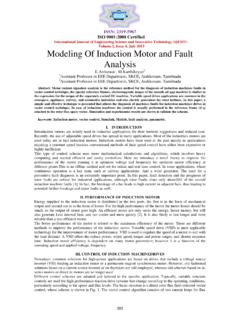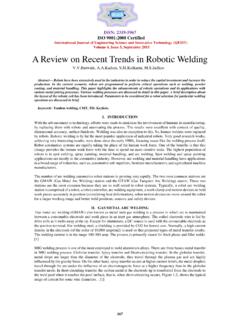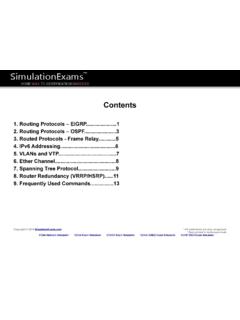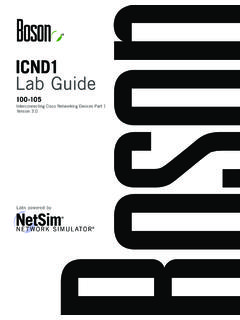Transcription of Analysis of RIPv2, OSPF, EIGRP Configuration on …
1 ISSN: 2319-5967 ISO 9001:2008 Certified International Journal of Engineering Science and Innovative Technology (IJESIT) Volume 4, Issue 2, March 2015 215 Analysis of ripv2 , OSPF, EIGRP Configuration on router Using CISCO Packet tracer Archana C Assistant Professor, Department of MCA, Institute of Technology, University of Mumbai, India Abstract-In this modern era the computer communication network is growing rapidly, Computer communication networks are based on a technology that provides the technical infrastructure, where routing protocols are used to transmit packets across the Internet.
2 Routing protocols specify how routers communicate with each other by spreading information. The router has prior knowledge about the adjacent networks, which can assist in selecting the routes between two nodes. There are various types of routing protocols being widely used. Enhanced Interior Gateway Routing Protocol ( EIGRP ) Routing Information protocol (RIP) and Open Shortest Path First (OSPF)have been considered as the pre-eminent routing protocols for real-time applications In this paper, we have analyzed and simulated a proposed wired Local Area Network using different routing protocols.
3 Therefore Configuration of these different routing protocols are done using CISCO packet tracer simulator. Index Terms: EIGRP , OSPF, RIP, VLSM. I. INTRODUCTION A Routing Protocol is a protocol that specifies how routers communicate with each other, disseminating information that enables them to select routes between any two nodes on a computer network [7]. Routing algorithms are responsible for selecting the best path for the communication a border way we can say that A routing protocol is the language a router speaks with other routers in order to share information about the reach ability and status of network [1].
4 Routing is often contrasted with bridging .The primary difference between both of them are the layer in which they are working. Metrics such as such as path bandwidth, reliability, delay, current load on that path etc are used by routing algorithms to determine the optimal path to a destination. The Routing is proceeding in such a way that first it shares information with its immediate neighbours, then thorough out the entire network. A. Classification of Routing protocols The routing is established by the Configuration of routing tables in the routers.
5 There are two different way to configure routing tables in router. They are static routing and dynamic routing. The figure 1 depicts the classification of routing protocols. Static routing is simply the process of manually entering routes into the routing table of a device using its a Configuration file that is loaded when the routing device starts up. In static routing, all the changes in the logical network layout need to be manually done by the system administrator. However, dynamic routing allows routers to select the best path when there is a real time logical network layout change.
6 Static routing is easy to implement in small networks. They are very safe and predictable as the route to the destination is always the remains same .Doesn't require any routing algorithm or update mechanisms. Hence no requirement of extra resources such as CPU and memory. But Dynamic routing protocols work well and Suitable in all typologies where multiple routers are required. They are scalable and automatically determine better routes if there is a change in the topology. The ability to scale and recover from internetwork faults makes dynamic routing the better choice for medium, large, and very large inter network.
7 The dynamic routing protocol is further classified into distance vector routing protocol and link state routing protocol. Distance vector protocol uses simple algorithms to calculate cumulative distance value between routers based on hop count. But link state protocols uses sophisticated algorithm that maintain complex data base of inter network topology ISSN: 2319-5967 ISO 9001:2008 Certified International Journal of Engineering Science and Innovative Technology (IJESIT) Volume 4, Issue 2, March 2015 216 Fig 1: Routing protocol classification . II. INTERIOR GATEWAY (IGP) VS EXTERIOR GATEWAY (EGP) A collection of routers under a common administration is termed as an autonomous system (AS) otherwise known as a routing domain.
8 Interior gateway protocols (IGP): IGP are routing with in a routing domain that is, routing inside an autonomous system Exterior gateway protocols (EGP): Used for inter-autonomous system routing, that is, routing between autonomous systems. Fig: 2 (IGP vs EGP) ISSN: 2319-5967 ISO 9001:2008 Certified International Journal of Engineering Science and Innovative Technology (IJESIT) Volume 4, Issue 2, March 2015 217 A. Routing Information Protocol (RIP) Routing information protocol is a standards-based, distance-vector, interior gateway protocol used by routers to trade routing information.
9 Interior gateway means it should be used for the routers in same domain network . The metric used in RIP to find out the best path between two locations is Hop count. Hop count is the number of routers the packet must go through till it reaches the destination network. The maximum allowable number of hops a packet can go across in an IP network implementing RIP is 15 hops. Routers using RIP publicize information about each subnet to their neighbours. Their neighbour in turn passes the information to the nearby neighbours of their own and so on until all the routers are alert of information.
10 RIP has two versions, Version 1 (RIPv1) and Version 2 ( ripv2 ). RIPv1 (RFC 1058) is classful, and thus does not include the subnet mask with its routing table updates. Because of this, RIPv1 does not support Variable Length Subnet Masks (VLSMs). When using RIPv1, networks must be contiguous, and subnets of a major network must be configured with identical subnet masks. RIPv1 sends updates as broadcasts to address (RFC 2543) is classless, and its include the subnet mask with its routing table updates. The enhancement of ripv2 are it is fully supports VLSMs, allowing discontinuous networks and varying subnet masks.














